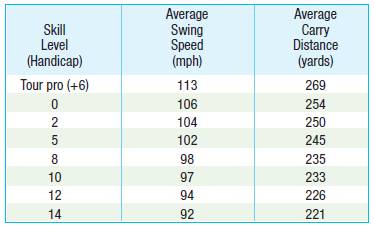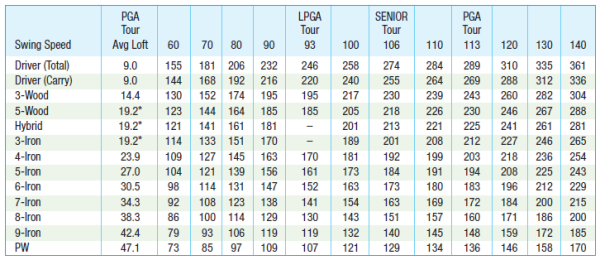How Important Is Distance In Golf?
 It seems everyone is enamored with distance these days. TV announcers gush over 300- yard drives, and we hear how Phil Mickelson is hitting a 7-iron from 190 yards. Is distance overrated, or is it important in today’s world?
It seems everyone is enamored with distance these days. TV announcers gush over 300- yard drives, and we hear how Phil Mickelson is hitting a 7-iron from 190 yards. Is distance overrated, or is it important in today’s world?
The answer is yes…to both questions. Yes, distance is overrated to a degree, but it’s also important in relation to our overall scoring ability. If we go back to 1980 and check the tour statistics for driver distance, the median was 257 yards. Those were the days of persimmon drivers and balata balls. Thirty-two players actually averaged under 250 yards. Yet, even these shorter hitters were able to shoot well under par on 7,000-yard courses, and also win, so it’s possible to play top-level golf without bombing it. And for years, the top 10 in driving accuracy always out-earned the top-10 in driving distance on the money list.
On the other hand, for the past few years on tour that trend has been reversed, with the bombers winning more money than the straight-and-narrow guys, 2013 excepted. We do know distance is important to scoring; can we quantify it?
According to the USGA Yardage Rating formula, every 220 yards in distance equates to one stroke in diffi culty for men; for women, that yardage is 180. Suppose a golfer could hit the ball 10, 20, or even 30 yards farther off the tee? How would that affect their overall scoring average, assuming no loss in skill?
A typical golf course features four par-3s, four par-5s and 10 par-4s. That’s 14 opportunities to hit the driver, and four more second shots on par-5s. A man who hits both his driver and 3-wood 10 yards longer shortens the course by 180 yards (180 / 220 = .8 stroke according to the Yardage Rating formula); 20 yards longer shortens it by 360 yards (1.6 strokes), and 30 yards longer shortens it by 540 yards (2.5 strokes). In other words, every 10-yard gain in driving distance theoretically makes the course about .8 strokes easier. That’s one way to look at it, but it’s not entirely accurate, as we’ll see.
Another is by swing speed. The average male touring pro swings his driver at 113 mph. The average male golfer swings 90 mph. Divide 90 by 113 and you get .796. If the typical tour course is 7,200 yards, the equivalent for an average man would be 5,731 yards. It’s a fair bet to say most men would play from the white tees at an average of 6,200 yards, which is equivalent to a touring pro playing from 7,789 yards. And, if that same average man were to play on the 7,200-yard course, that would be like a touring pro playing from 9,045 yards!
In doing the math, if an average golfer were to increase his swing speed from 90 mph to 113, he would gain 55 yards in driving distance (it’s generally accepted that each mph increase in swing speed results in approximately 2.4 more yards of carry). Using our formula of making the course .8 strokes easier for every 10 yards gained, this would mean making the course 4.4 shots easier. Yet, if we compare playing the 7,200 yards a typical touring pro plays from, to an average man playing from 5,731 yards, that’s a difficulty difference of 6.7 shots ((7,200 – 5,731) / 220), not 4.4. And if we compare the 6,200-yard course the average man plays from to a touring pro playing from 7,789 yards, that’s a difference of 7.2 shots. Why the discrepancies from 4.4 shots, as in our calculation?
The answer is that every club is affected by a change in swing speed, not just the driver and 3-wood. It also depends on the length of the course. Longer hitters, as we saw in our example, indeed have a proportionally greater advantage on longer courses. So, to try to answer our original question – how many strokes will someone improve if they increase their driver yardage 10, 20, or 30 yards? – is dependent on how far someone already hits the ball and how long the course is.
To make it simple, let’s use the example of the average golfer who swings 90 mph and plays on a 6,200-yard course. To gain 10 yards (assuming optimum driver specs), he needs to increase his swing speed 4.17 mph (10 / 2.4). This would effectively shorten the course for him to 5,925 yards (6,200 / (94.17 / 90)). That’s a difference of 275 yards, or 1.3 strokes under the USGA Yardage Rating formula. A 20-yard increase shortens the course another 250 yards to 5,675, making it 2.4 strokes easier; and, a 30-yard increase further shortens the course effectively to 5,444 yards, making it 3.4 strokes easier. If this golfer typically plays from a longer yardage, say 6,800 yards, the savings in strokes becomes slightly more pronounced: 10 yards = 1.4 strokes; 20 yards = 2.6 strokes; and 30 yards = 3.8 strokes.
Distance and Skill Level
The chart above shows the average swing speeds for various skill levels for male players, from touring pros to 14-handicappers, and carry distance on optimal contact:
This chart shows averages. Obviously, for each skill level, there are golfers both well below and well above the averages. What this shows us is that golfers who swing below average for their handicap level are actually more skilled than others of their handicap level. It also shows that golfers who wish to lower their handicaps, but who do not have the swing speed for the lower handicap level, are facing a tough battle.
Most golfers who are double-digit handicappers don’t have fundamentals that allow them to achieve their maximum swing speed, so instruction can greatly help in this matter. For those who have good mechanics, increasing swing speed is a matter of training for clubhead speed. Two sources to investigate are Ben Jackson’s website at www.BenJacksonGolf.com and Jaacob Bowden’s www.SwingManGolf.com.

The chart above, courtesy of Jaacob Bowden, gives us a good idea of how far everyone should hit each club, based on their driver clubhead speed. You can use this chart to tweak your players’ equipment. Say someone is hitting all their irons the distances listed under the 80 mph category, but hitting their driver only 175 yards total. Their driver specs are probably not correct, and usually this means the player is not using enough loft or the shaft may be too stiff. Or, suppose they are not hitting their irons as far as their driver distance indicates they should. They could
have iron lofts weaker than what the chart indicates, or maybe the shafts are incorrect, or the head design might not be correct for their swing.
Overview
Distance is definitely a factor in today’s game, but players with lesser clubhead speeds are still able to play at a fairly high level. On a Champions Tour broadcast on Golf Channel, one of the announcers said that for short hitters to compete at the professional level, there were three things they couldn’t be: crooked, a bad putter, or stupid. This advice is valid for more than just short hitters at the professional level; it’s valid for all short hitters at all levels. While not being stupid may have been said somewhat in jest, it points to the fact that shorter hitters have to manage their games at a high level.
Long hitters are able to get away with a lesser skill level than short hitters and still beat them, but they have their own challenges. Many times we can observe long hitters who have poor abilities from inside 100 yards, or who have severe accuracy issues off the tee. Long hitters need to realize they don’t always have to hit their driver off the tee and that their added length allows them the luxury to hit a fairway wood or hybrid, often still past the shorter or average hitters. Because the approach shot is the most important on any given hole, it’s crucial that the long hitter makes sure he has a feasible approach shot.




